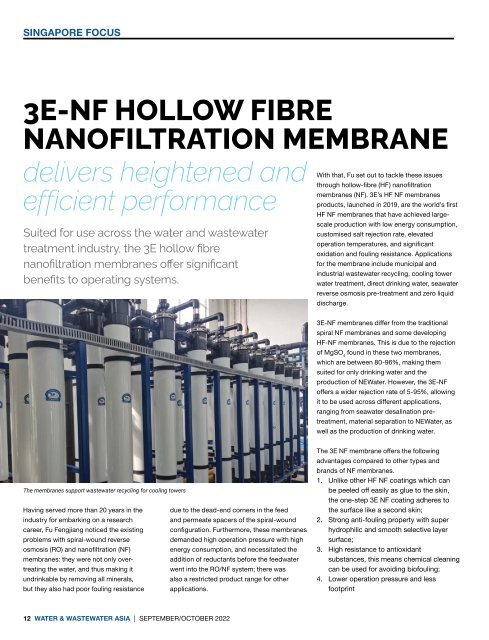Water & Wastewater Asia September/October 2022
Water & Wastewater Asia is an expert source of industry information, cementing its position as an indispensable tool for trade professionals in the water and wastewater industry. As the most reliable publication in the region, industry experts turn this premium journal for credible journalism and exclusive insight provided by fellow industry professionals. Water & Wastewater Asia incorporates the official newsletter of the Singapore Water Association (SWA).
Water & Wastewater Asia is an expert source of industry information, cementing its position as an indispensable tool for trade professionals in the water and wastewater industry. As the most reliable publication in the region, industry experts turn this premium journal for credible journalism and exclusive insight provided by fellow industry professionals. Water & Wastewater Asia incorporates the official newsletter of the Singapore Water Association (SWA).
Create successful ePaper yourself
Turn your PDF publications into a flip-book with our unique Google optimized e-Paper software.
SINGAPORE FOCUS<br />
3E-NF HOLLOW FIBRE<br />
NANOFILTRATION MEMBRANE<br />
delivers heightened and<br />
efficient performance<br />
Suited for use across the water and wastewater<br />
treatment industry, the 3E hollow fibre<br />
nanofiltration membranes offer significant<br />
benefits to operating systems.<br />
With that, Fu set out to tackle these issues<br />
through hollow-fibre (HF) nanofiltration<br />
membranes (NF). 3E’s HF NF membranes<br />
products, launched in 2019, are the world’s first<br />
HF NF membranes that have achieved largescale<br />
production with low energy consumption,<br />
customised salt rejection rate, elevated<br />
operation temperatures, and significant<br />
oxidation and fouling resistance. Applications<br />
for the membrane include municipal and<br />
industrial wastewater recycling, cooling tower<br />
water treatment, direct drinking water, seawater<br />
reverse osmosis pre-treatment and zero liquid<br />
discharge.<br />
3E-NF membranes differ from the traditional<br />
spiral NF membranes and some developing<br />
HF-NF membranes. This is due to the rejection<br />
of MgSO 4<br />
found in these two membranes,<br />
which are between 80-96%, making them<br />
suited for only drinking water and the<br />
production of NE<strong>Water</strong>. However, the 3E-NF<br />
offers a wider rejection rate of 5-95%, allowing<br />
it to be used across different applications,<br />
ranging from seawater desalination pretreatment,<br />
material separation to NE<strong>Water</strong>, as<br />
well as the production of drinking water.<br />
The membranes support wastewater recycling for cooling towers<br />
Having served more than 20 years in the due to the dead-end corners in the feed<br />
industry for embarking on a research<br />
and permeate spacers of the spiral-wound<br />
career, Fu Fengjiang noticed the existing configuration. Furthermore, these membranes<br />
problems with spiral-wound reverse<br />
demanded high operation pressure with high<br />
osmosis (RO) and nanofiltration (NF)<br />
energy consumption, and necessitated the<br />
membranes: they were not only overtreating<br />
the water, and thus making it<br />
went into the RO/NF system; there was<br />
addition of reductants before the feedwater<br />
undrinkable by removing all minerals,<br />
also a restricted product range for other<br />
but they also had poor fouling resistance applications.<br />
The 3E NF membrane offers the following<br />
advantages compared to other types and<br />
brands of NF membranes.<br />
1. Unlike other HF NF coatings which can<br />
be peeled off easily as glue to the skin,<br />
the one-step 3E NF coating adheres to<br />
the surface like a second skin;<br />
2. Strong anti-fouling property with super<br />
hydrophilic and smooth selective layer<br />
surface;<br />
3. High resistance to antioxidant<br />
substances, this means chemical cleaning<br />
can be used for avoiding biofouling;<br />
4. Lower operation pressure and less<br />
footprint<br />
12 WATER & WASTEWATER ASIA | SEPTEMBER/OCTOBER <strong>2022</strong>


















